Germany
Germany
The following Nativities are each displayed in a unique permanent setting created by Marian Library Crèche Collection volunteers. The descriptive text for each was written by Father Johann Roten, S.M.
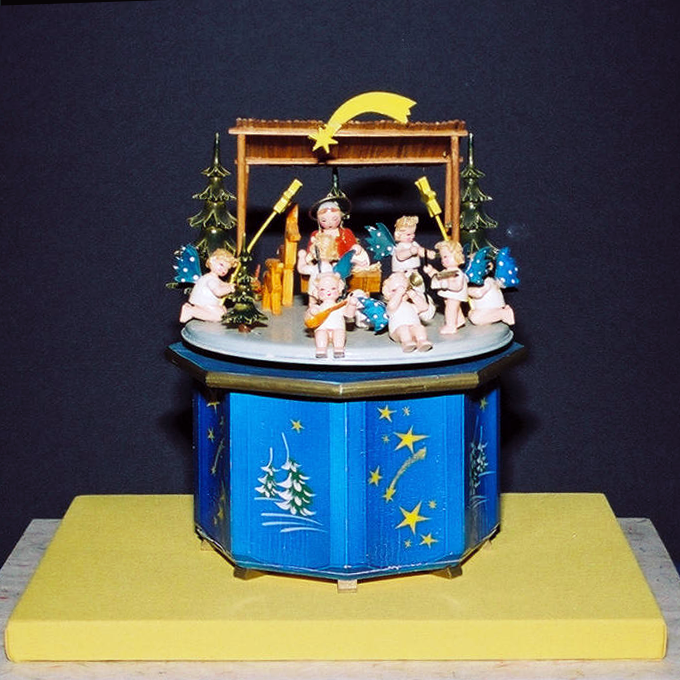
What Goes Around…
Seiffener Tradition
This six-sided music box ornated with nativity figures, the little musician-angels in particular, is part of the classical Christmas tradition of German culture. It was purchased in Germany probably in the early 1950s by Colonel Wilbur Showalter and his wife Lucile. Dating back to the end of the eighteenth century, today’s music boxes recapture memories of an earlier era. At the time, music boxes enabled families to dance and enjoy popular music in the privacy of their homes. They were also an early and simplified version of mechanical crèches. Today nativity music boxes are a reminder of “what goes around, comes around,” the annual remembrance of Christ’s birth.
– ML.1114.02
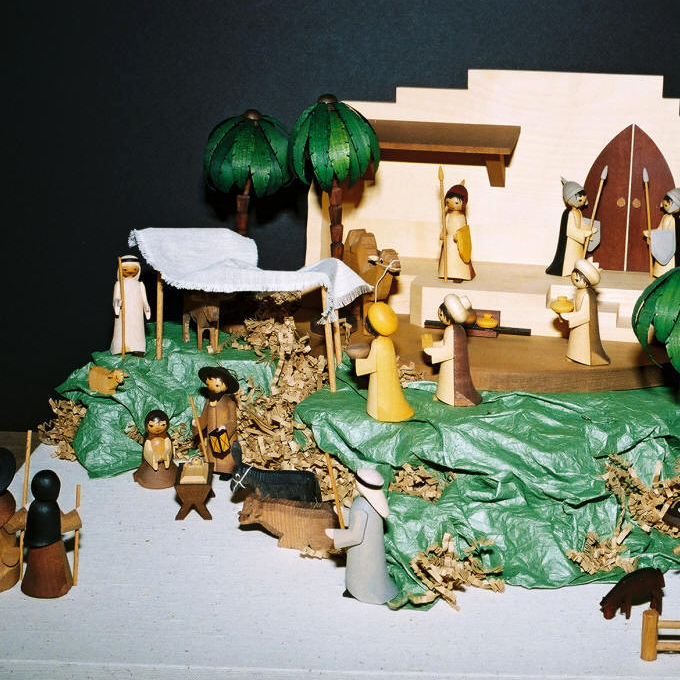
Happy to Serve
Seiffener Tradition
Figures of the Erzgebirge, a region south of Dresden (Germany), cannot compete with Hummel, Lladro and the masterpieces of Neapolitan art. They have a modest charm which points beyond individual character and personal importance. These simple figures of turned wood with their broad-rimmed hats and wide mantles are at their best when they come as a group. Where there is company, there is a story. Seiffener figures have a narrative function. They are story tellers; better, they serve the story of Christ’s birth. Once they have captured the attention of the onlooker, they inspire him/her to contemplate the deeper meaning of what they represent. They are happy to serve.
– ML.1114.03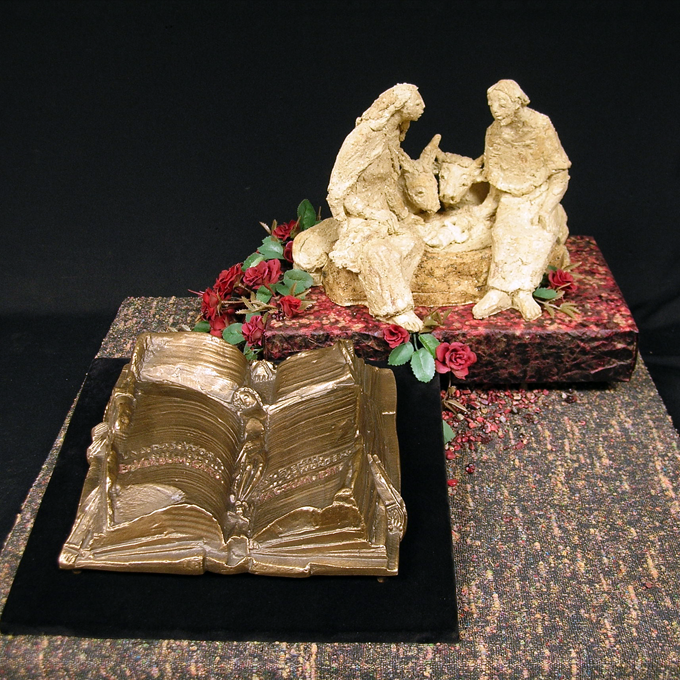
Cradle and Cross
Caritas Müller, Hans Wachter
(Germany/Switzerland)
Cradle and cross are never far apart in Christian thought. The first leads to the second, as certain as Christmas leads to Easter. At first sight, this double set is made of contrasts. Stoneware clashes with bronze, and the lovely nativity group seems to disagree with the stylized forms of book and cross. In fact, there is complimentarily in color and weight: both lend a discreet nobility to the book as well as to the cradle. The delightful idyll of parents and animals gathered around the child is not without foreboding. The insouciant animal companions contrast somewhat with the more reflective parents. They seem perplexed and helpless, somehow anticipating the next scene with the crucified Son at its center. Tucked between the pages of the book of life, the Savior on the cross looks like a pressed flower. He is a constant reminder that the many pages of his message are drawing their fullness of meaning from his death and resurrection. Thus, cradle and cross have a twofold meaning. They both speak the language of Christmas and Easter.
– ML.0110.14
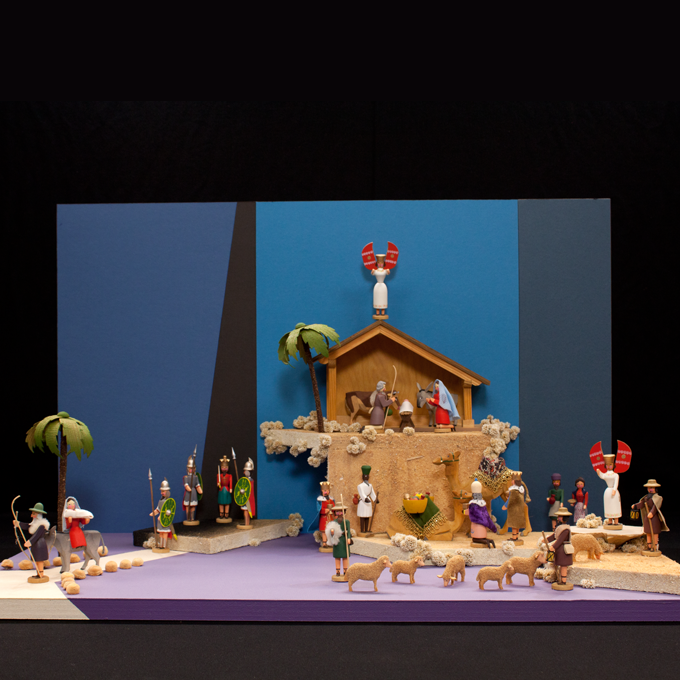
Adored and Persecuted
Walter Werner
Representative of the rich creche culture of the Erzgebirge region of East Germany, this set was crafted by Seiffener artist, Walter Werner. Its many figures are of rounded wood, of simple and almost childlike forms, but adorned with great love of detail for both color and accessories. Angels have red wings, the camel carries baskets with manifold, colorful gifts, Joseph has a green broad-rimmed hat, and Herod looks exceedingly grim. In fact, this nativity also shows the flight into Egypt, with Herod's regiments in pursuit of the Holy Family. The infant Messiah is adored and persecuted, anticipating thus the future destiny of his person and mission. He remains a challenge to this day to both those who adore him and those who persecute him.
– ML.2627
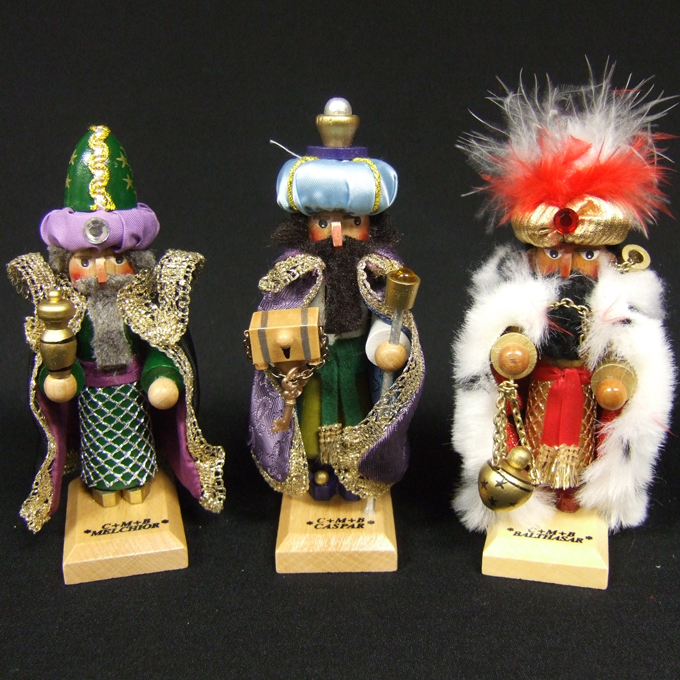
Nutcracker Suite
Christian Steinbach (Smithsonian)
Nutcracker figurines from Saxony are well known in many parts of the Western world. Square-faced and stern-eyed they have lent their limbs of turned wood to dozens of different characters. Christian Steinbach designed these three wise men and clothed them in exquisite finery, creating thus a telling contrast between the stark and awkward simplicity of the wooden figures and their rich, colorful and elegant robes – all of satin, silk and fur! His wise men teach us an important lesson. Even a timid and helpless heart will brightly shine forth, if and when bringing generous gifts to the manger.
– ML.1119.05
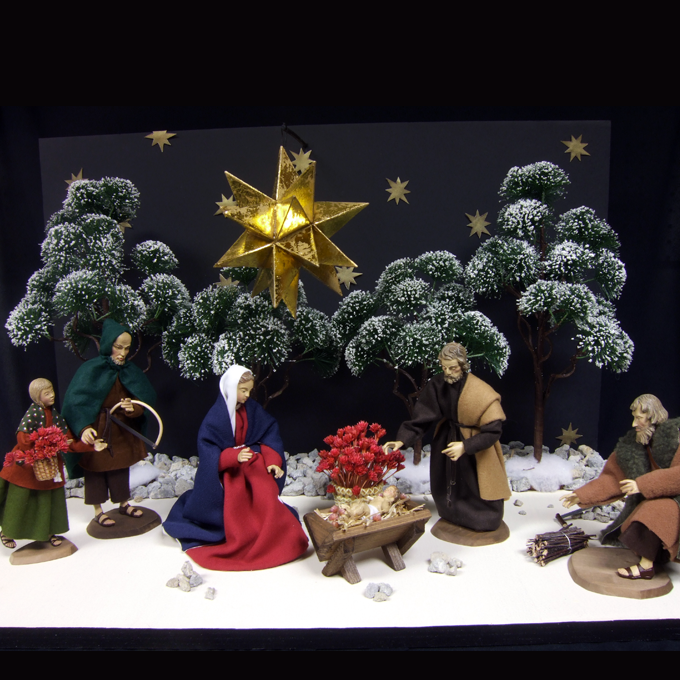
A Starry Night
Dammer Family
These figures are classical examples of German crèche culture. Their members are moveable, the colors subdued but elegant, the dresses of rich texture but simple. Mary wears the traditional white, blue and red. Joseph is clad in brown tones, and the features of all the figures show pronounced individuality. In this scene the figures clash with the cold, starry winter night in which they are set. Cold and warm colors battle with each other. White, gray and black create a wall of hostility and indifference. Stars scattered over the dark skies, the powerful lone star hovering over the Child, and the five pairs of sensitive hands stretched out toward the manger – they all attempt to counterbalance the weight of cold and darkness, that is, of insensitivity and senselessness. The blooming flowers in deep winter stand for a new spring, and the end of a long, starry night.
– ML.0106.13
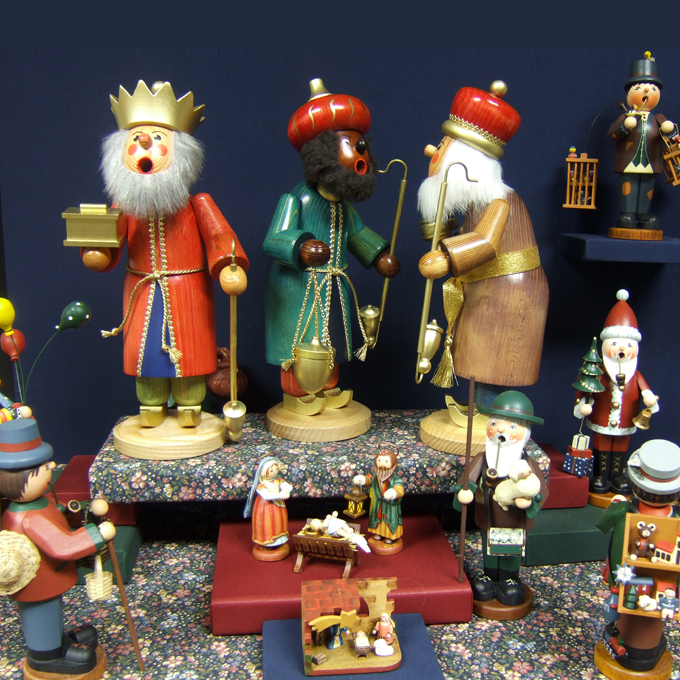
"Holzknoddl"
Käthe Wohlfahrt
These sturdy little figures, called "Holzknoddl" or wooden dumplings, are in fact, sophisticated smokers. A burning incense cone is placed inside the smokers, and soon drifting scents and lovely aromas will come out of the smoker's mouth and fill your home. From toy peddler to chimney sweeper, the "Holzknoddl's" name is legion. There is hardly any place left for a miniature nativity.
– ML.1125.01
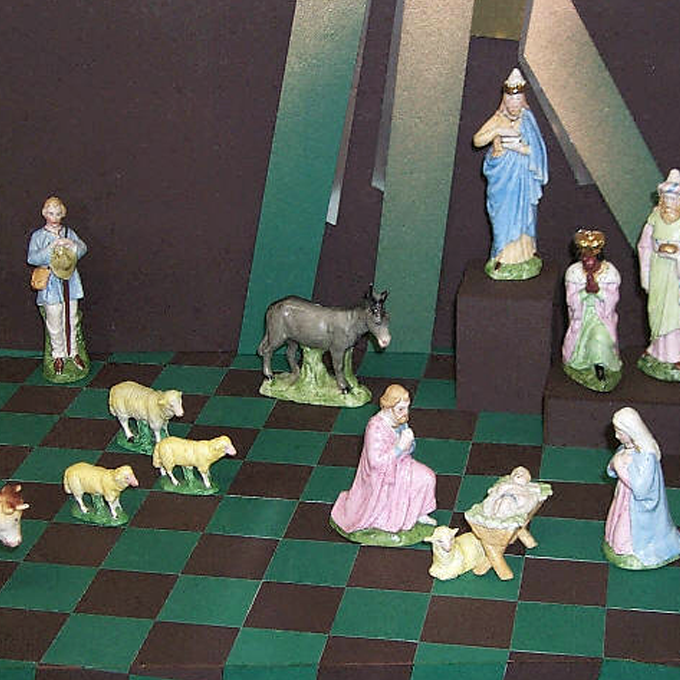
A New Look
Unknown artist
The porcelain figures of this set are unassuming and without great artistic quality. They were mass-produced and represent the standard nativity figures of the thirties and forties of the last century. However, set against the abstract backdrop of a green and black checkerboard we are afforded a new look at these weathered representatives of the Nativity. And we discover beauty anew, where boredom and indifference had set in.
– ML.2617
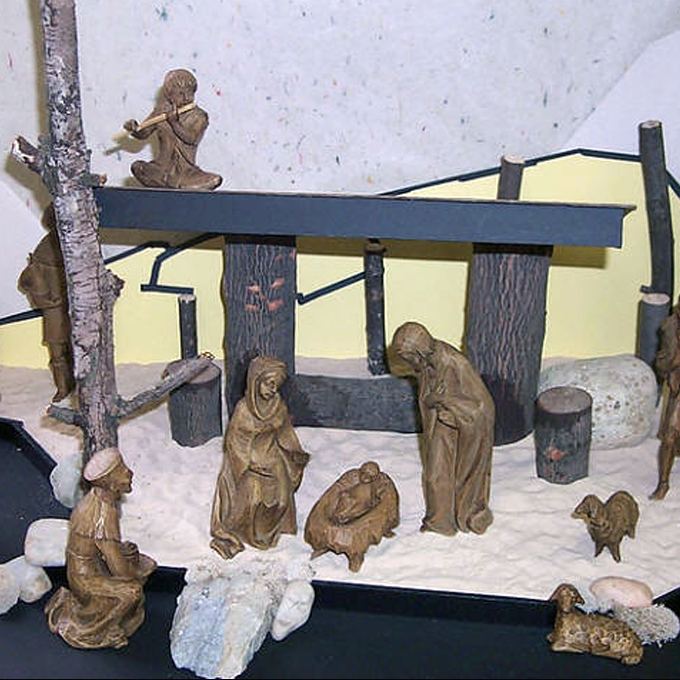
The Piper on the Roof
Hilger Family
This wood carved nativity set from the northern regions of Germany is a study in contrasts. The wintry landscape is interspersed with tree trunks of all sizes and shapes: some short and sturdy, others tall and twisted but none of them carrying branches or foliage. They suggest a forest of stalks and stumps, a landscape destroyed by fire or war, and of dead wood in deep winter. The association that comes to mind is one of a culture of death surrounding the event of the incarnation, symbol of new life and living hope.
This contrast between life and death is deeply ingrained in the Christmas traditions of northern countries. Although a season of snow and frost, Christmas has apples growing on trees and roses blooming on bushes. It tells us that the birth of Christ upsets even nature, and turns its laws upside down. The delicately carved figures of Mary and Joseph express tender care and concern for the one who calls himself the life and light of the world. The Magi in their exotic dress stand or kneel in satisfied awe: They have found the one announced by the star, and they know that the baby on the straw holds in his tiny hands the future of the world. By contrast, the shepherd does not hold the same rich certitude. He is dressed in shreds, his steps are hesitant, and the expression of his face is torn between doubt and hope. But in his left hand he carries a little lamb as pledge of his faith. And then there is the boy piper sitting on the roof of a shelter not unlike that of Romulus and Remus in Roman mythology. Sitting high in the tailor's seat, and dominating the whole scene, he seems completely absorbed in his music. The flute he is playing could have been carved from one of the tree trunks surrounding the hut, but the melody he is drawing from it is dedicated to the Child on the straw bed. The little piper on the roof embodies the always painful reconciliation between the culture of death and the culture of life. He is a reminder that in Jesus Christ death is changed into life.
– ML.0076.23
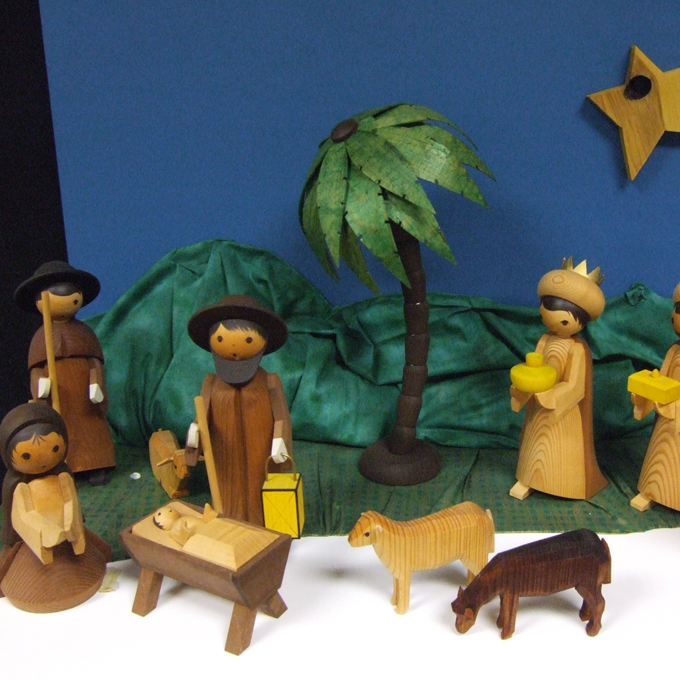
Like Screen Savers
Seiffener Ateliers
South of Dresden, Germany, there lies the romantic Erzgebirge known for its wooded hills and hidden valleys. People living in these valleys are the guardians of a centuries' old tradition of woodcarving, famous for its nativity figures of rounded wood, and simple and almost childlike forms. Much of the pastoral charm of these valleys went into the creation of the broad-brimmed hats and wide mantles which characterize the pious country folk gathered around the manger.
The figures convey a hands-on message. We are from Seiffen in the Erzgebirge, they tell us, and cannot compete with brand names like Hummel and Lladro. We are unpretentious and easy-going: we are everybody's figures. Even you could have crafted us. Seiffener figures create a climate of familiarity, of deja vu and childlike pleasure. Most important, they draw the onlooker into the holy event of Christmas, giving him/her the impression of being part of the cast. The secret of these figures is to let go. Once they have captured the attention of the visitor, they are leading him/her on to meditate the deeper meaning of what they represent. These are selfless little characters, like screen-savers on the computer. They are happy to serve.
– ML.2616
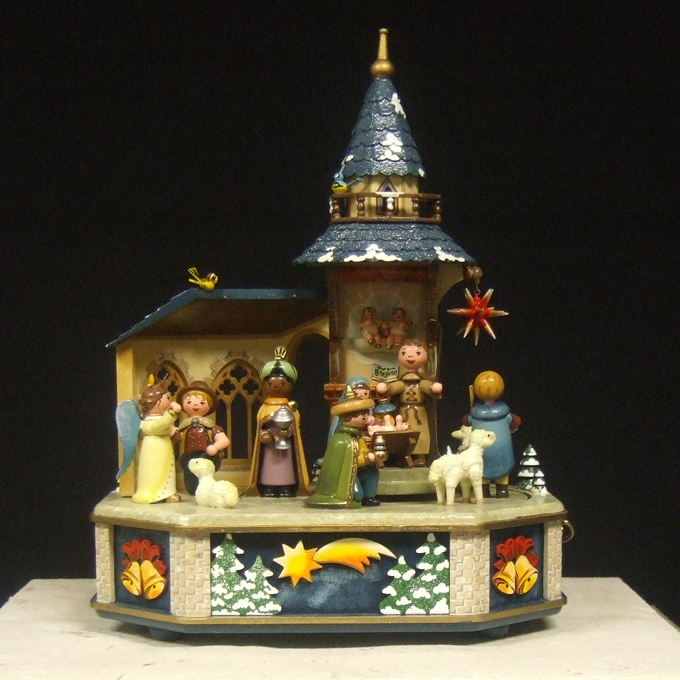
Sound of Music
Käthe Wohlfahrt
This six-sided music box with Nativity figures turning to the sound of music, in fact, that of "Silent Night," represents one of the classical Christmas traditions of German culture. Dating back to the end of the eighteenth century, today's music boxes recapture memories of an earlier era. The figures are of turned wood and are colorfully hand-painted. The music coming from the box has the lyrical sound of childhood magic.
– ML.1125.02
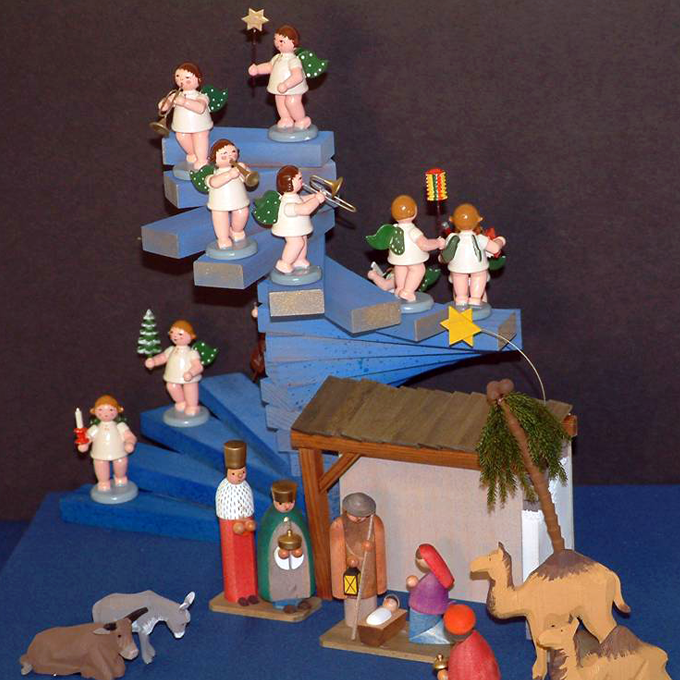
The Downward Staircase
Günter Reichel
Popular culture abhors sophistication and thrives on candor. In this set from the Erzgebirge region (Sachsen), toy figures, turned wood, and bright colors are the sole ingredients of Christmas lore. The Christmas joy of the simple-hearted resonates with the poor in spirit of the Beatitudes. The little angels descending a monumental staircase leading to the modest hut of the Emmanuel, are a playful but poignant reminder that in Christ the divinity has descended into human flesh.
– ML.1118.04
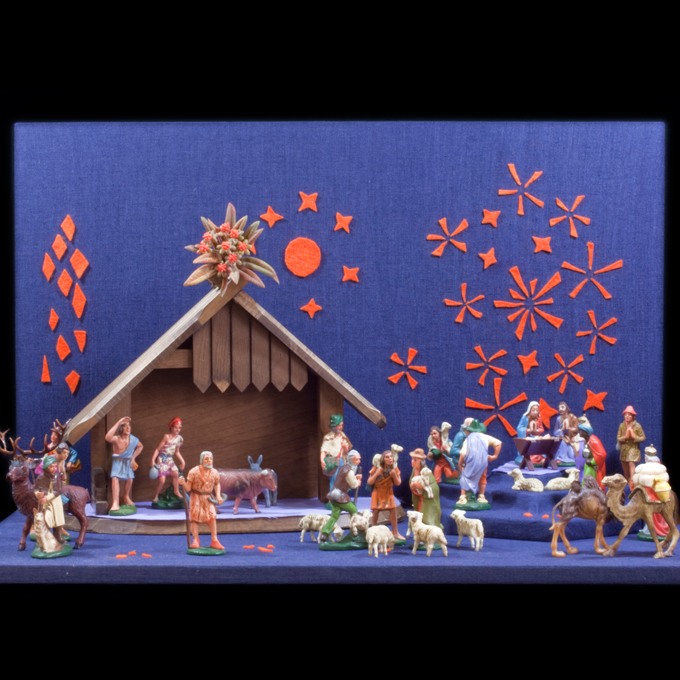
Apparent and Hidden
Unknown artist
This could be a traditional setting; the typical post-war I German plethora of cheap and colorful little figures, unpretentious but expressive in look and posture. But no! This nativity set is the harbinger of some hidden messages. See the stable without the Holy Family. According to old, very old tradition (Pseudo-Mathew), Jesus was born in a cave. The Holy Family moved to the stable only on the third day after his birth. Or, take a look at the lone orange figure in the center. He speaks to the visitor. He is the prophet and announces in German crèche culture the beginning of Advent and the coming season. And there is an explosion of light where the Christ Child rests. Light symbolism plays an important role in religion. Our way to God is marked by the light of human reason (streaks of light on the left), the light of nature (moon and stars), and the revelation of God in Jesus Christ — a true explosion of light.
[Elisabeth van Mullekom Collection]
– MLA.557
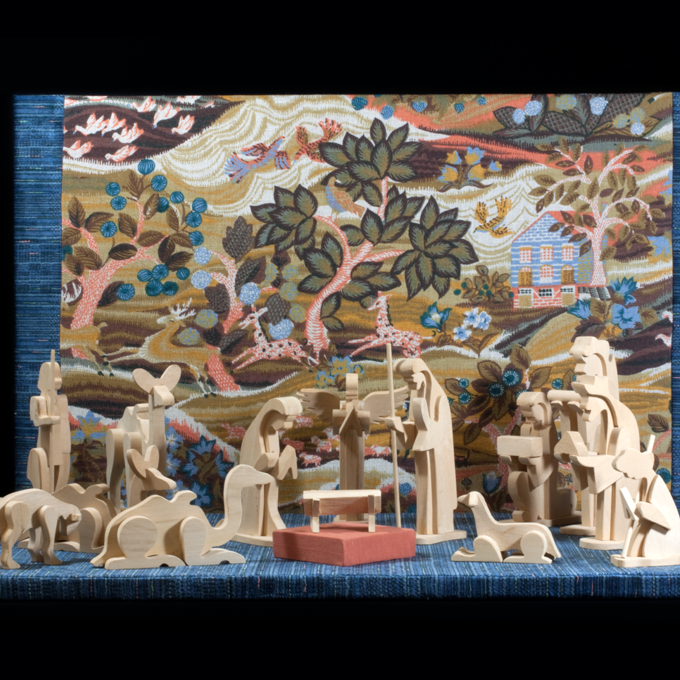
Life is Expectation
Unknown artist
Notice the empty manger. The royal court has convened. Everybody is in attendance, only the baby is missing. One of the many Christmas traditions sees the manger scene as a work in progress. Figures are added as Advent progresses. The first figure to be placed in the pre-arranged landscape is the storyteller announcing future events. The last figure is the Christ Child. It will be brought in joyful procession to the manger and laid down on straw at the tune and dance of "In dulce Jubilo." This nativity set takes up the idea that life is expectation. The backdrop signals future joy, a slice of paradise restored. In the foreground everything is ready as mechanical figures are ready when on hold. Straight off the assembly line, one might say, these figures are waiting for the breath of life that will put flesh on their skeletons and movement in their limbs. They are waiting not for God but for the Christ Child.
[Elisabeth van Mullekom Collection]
– MLA.286
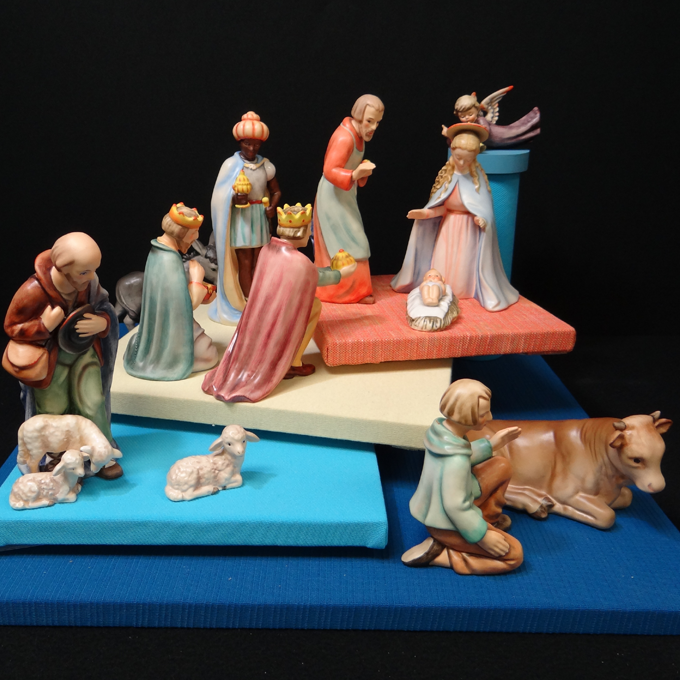
A Collectible?
M. I. Hummel
A Hummel figure is more than a simple figure. It has long ago received the title of nobility, making it a collectible, and entitling it to be a coveted icon of collectors, fan clubs and limited series. It is also a well-deserved and posthumous tribute to the humble artistic genius of a religious sister who wanted people to look at holy figures with children's eyes and behold them with a child's heart. Her porcelain creations are like a passport to paradise lost, for a time at least.
The presentation of this set breaks with the traditional alignment of crèche figures, clustering them in groups and according to levels. Using the primary Hummel colors of red and blue to divide and regroup, Michel Forest imparts new intensity to the central actors, and consigns magi and shepherds to reverent distance. Thus, a collectible is no longer only a collectible but becomes a ladder of ascent to greater aesthetic and religious awareness.
– ML.0116.07
